Off the Shelf #16 Beyond the Inland Sea: Homosexuality in Japanese History and Culture
By Rob Ridinger
Japan has always had an air of elusive mystery about it to Westerners, a fascination which began with Commodore Matthew Perry’s naval expedition in July 1853 whose goal was the “opening” of two Japanese ports to foreign trade. With this achieved, awareness of this long-closed and unfamiliar society began to grow, and the popular images of the archipelago (such as Mount Fujiyama, the highly structured tea ceremonial, crimson torii gates, and the warrior traditions of the samurai) took root in the Western mind. As in neighboring China, same-sex relationships had been present in Japanese society for centuries, were given a specific name in the language (nanshoku), and a body of literature in English has been generated over the last thirty years making this uniquely complex world accessible. In the pre-Stonewall era of LGBT history, one Japanese writer created controversial works involving homosexuals and achieved international recognition. Writing under the pseudonym of Yukio Mishima, he presented gay male characters to the English reading public, beginning in 1953 with Forbidden Colors (in the researching of which he visited gay bars) and in 1958 the widely translated Confessions Of A Mask. Forbidden Colors was not translated into English until 1968, and was reissued in 1999.
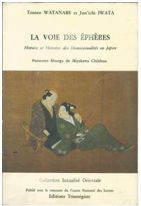 One of the earliest sources which can serve as background reading on same-sex relationships in Japan is a brief article published in 1983 in the English translation of the Kodansha Encyclopedia of Japan. The authors provide an outline of the degree to which male homosexual relationships were accepted in classes as diverse as the Buddhist clergy, the shoguns and their courts, and the actors in the No and kabuki theaters. The Kodansha also has an article on the prolific seventeenth-century writer and poet Saikaku (1642-1693) , who authored the 1687 story collection Nanshoku okagami (The Great Mirror of Male Love) on the idealized homosexual relationships of the samurai. Two years after the publication of the Encyclopedia, Paul Schalow produced a translation of Nanshoku okagami as his Ph.D dissertation at Harvard, making this classic work accessible to the English reading public. The decade closed with an English translation of La Voie des Éphèbes by Tsuneo Watanabe, originally published in Paris in 1987. Its English translation appeared two years later from the Gay Men’s Press in London under two different titles, Love of the Samurai : A Thousand Years of Japanese Homosexuality and Screening The Male : A Thousand Years of Japanese Homosexuality.
One of the earliest sources which can serve as background reading on same-sex relationships in Japan is a brief article published in 1983 in the English translation of the Kodansha Encyclopedia of Japan. The authors provide an outline of the degree to which male homosexual relationships were accepted in classes as diverse as the Buddhist clergy, the shoguns and their courts, and the actors in the No and kabuki theaters. The Kodansha also has an article on the prolific seventeenth-century writer and poet Saikaku (1642-1693) , who authored the 1687 story collection Nanshoku okagami (The Great Mirror of Male Love) on the idealized homosexual relationships of the samurai. Two years after the publication of the Encyclopedia, Paul Schalow produced a translation of Nanshoku okagami as his Ph.D dissertation at Harvard, making this classic work accessible to the English reading public. The decade closed with an English translation of La Voie des Éphèbes by Tsuneo Watanabe, originally published in Paris in 1987. Its English translation appeared two years later from the Gay Men’s Press in London under two different titles, Love of the Samurai : A Thousand Years of Japanese Homosexuality and Screening The Male : A Thousand Years of Japanese Homosexuality.
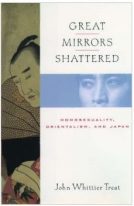 The 1990s were less prolific in regard to purely historical works on LGBT Japan, although literature continued to be a focus of interest. . Gary Leupp’s Male Colors: The Construction of Homosexuality In Tokugawa Japan appeared in 1995, followed in 1996 by Partings At Dawn: An Anthology of Japanese Gay Literature from Gay Sunshine Press in San Francisco, edited by Stephen D. Miller and Paul Schalow. The individual view continued in 1998 with a second anthology Queer Japan: Personal Stories of Japanese Lesbians, Gays, Transsexuals, And Bisexuals edited by Barbara Summerhawk and Cheiron McMahill from New Victoria Publishers. The stream of translated works from Japanese literature was also expanded in 1998 with Richard Cleaver’s master’s thesis at Sheffield Univeristy’s School of East Asian Studies Men I Have loved : A Japanese Gay Memoir : An Annotated Translation of Umeki Shigenobu’s Ore ga aishita otokotachi .And the historical orientation initiated by Love Of The Samurai was continued in 1999 through an examination of textual sources in Cartographies of Desire : Male-male Sexuality In Japanese Discourse, 1600-1950 by Gregory Pflugfelder from the University of California Press. That same year, a dissertation written by Joseph Raymond Hawkins was accepted at the University of Southern California, Invisible people: An ethnography of same-sexuality in contemporary Japan. The most deftly titled work to appear as the twentieth century ended was John Whittier Treat’s memoir of one year in his life as a scholar of Japan knowledgeable about its hidden LGBT side. Great Mirrors Shattered: Homosexuality, Orientalism, and Japan takes its title from Saikakau’s 1687 anthology, and the author explores the impact of AIDS on the Japan of the late 1980s within the perspectives of Orientalism, which he defines as “the Western study of everywhere else “ (Treat, p. ix) using his own experiences as both an account of the times and a consideration of how sexual identities are perceived and defined cross-culturally. A new edition of Mishima’s Forbidden Colors was also published in 1999.
The 1990s were less prolific in regard to purely historical works on LGBT Japan, although literature continued to be a focus of interest. . Gary Leupp’s Male Colors: The Construction of Homosexuality In Tokugawa Japan appeared in 1995, followed in 1996 by Partings At Dawn: An Anthology of Japanese Gay Literature from Gay Sunshine Press in San Francisco, edited by Stephen D. Miller and Paul Schalow. The individual view continued in 1998 with a second anthology Queer Japan: Personal Stories of Japanese Lesbians, Gays, Transsexuals, And Bisexuals edited by Barbara Summerhawk and Cheiron McMahill from New Victoria Publishers. The stream of translated works from Japanese literature was also expanded in 1998 with Richard Cleaver’s master’s thesis at Sheffield Univeristy’s School of East Asian Studies Men I Have loved : A Japanese Gay Memoir : An Annotated Translation of Umeki Shigenobu’s Ore ga aishita otokotachi .And the historical orientation initiated by Love Of The Samurai was continued in 1999 through an examination of textual sources in Cartographies of Desire : Male-male Sexuality In Japanese Discourse, 1600-1950 by Gregory Pflugfelder from the University of California Press. That same year, a dissertation written by Joseph Raymond Hawkins was accepted at the University of Southern California, Invisible people: An ethnography of same-sexuality in contemporary Japan. The most deftly titled work to appear as the twentieth century ended was John Whittier Treat’s memoir of one year in his life as a scholar of Japan knowledgeable about its hidden LGBT side. Great Mirrors Shattered: Homosexuality, Orientalism, and Japan takes its title from Saikakau’s 1687 anthology, and the author explores the impact of AIDS on the Japan of the late 1980s within the perspectives of Orientalism, which he defines as “the Western study of everywhere else “ (Treat, p. ix) using his own experiences as both an account of the times and a consideration of how sexual identities are perceived and defined cross-culturally. A new edition of Mishima’s Forbidden Colors was also published in 1999.
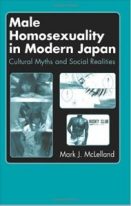 The new millennium opened with Mark J. McLlelland’s Male Homosexuality in Modern Japan: Cultural Myths and Social Realities., published by Curzon in 2000. In the introduction , there is a section on “ Japanese Terms Describing Same-Sex Attraction “ which follows the evolution of Japanese terms for homosexuals from the traditional nanshoku categories to terms adopted or adapted from Western terminology. Perhaps the most important personal testimony yet placed in the public sphere by any Japanese homosexuals appeared in English translation from Trans Pacific Press in Melbourne, Australia in 2001. Coming Out in Japan : The Story of Satoru and Ryuta was formed from the texts of two separate publications issued in Japan in 1993 and 1994 by each member of a male couple who had chosen to be open about their identities in a fiercely heteronormative society. Both Satoru Ito and Ryuta Yanase frankly share their journeys to self-acceptance and forming a life partnership, and in so sharing illuminate the social situation of LGBT people in Japan and the prejudices and stereotypes against homosexuals that remain to be challenged and changed. It is also noteworthy that Coming Out in Japan is dedicated to the memory of Matthew Shepard. The comments of the translator in his preface sharing his view of Japanese society’s attitudes towards homosexuality on two separate visits are also valuable.
The new millennium opened with Mark J. McLlelland’s Male Homosexuality in Modern Japan: Cultural Myths and Social Realities., published by Curzon in 2000. In the introduction , there is a section on “ Japanese Terms Describing Same-Sex Attraction “ which follows the evolution of Japanese terms for homosexuals from the traditional nanshoku categories to terms adopted or adapted from Western terminology. Perhaps the most important personal testimony yet placed in the public sphere by any Japanese homosexuals appeared in English translation from Trans Pacific Press in Melbourne, Australia in 2001. Coming Out in Japan : The Story of Satoru and Ryuta was formed from the texts of two separate publications issued in Japan in 1993 and 1994 by each member of a male couple who had chosen to be open about their identities in a fiercely heteronormative society. Both Satoru Ito and Ryuta Yanase frankly share their journeys to self-acceptance and forming a life partnership, and in so sharing illuminate the social situation of LGBT people in Japan and the prejudices and stereotypes against homosexuals that remain to be challenged and changed. It is also noteworthy that Coming Out in Japan is dedicated to the memory of Matthew Shepard. The comments of the translator in his preface sharing his view of Japanese society’s attitudes towards homosexuality on two separate visits are also valuable.
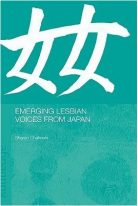 The lack of formal research works on lesbian identity in Japan was filled in 2002 by Sharon Chalmers with the publication of her interdisciplinary study Emerging Lesbian Voices in Japan, with much of the data included dating from the 1990s. The November 2002 issue of Sexualities contained an article entitled “Virtual Ethnography: Using the internet To Study Gay Culture in Japan “written by Mark McClelland. In it, he offers a unique perspective on the ways the Internet has assisted in the making of connections among Japanese gay men and discusses the impact that his own coming out to his interview subjects had in terms of accessibility to personal and community information. Building on his earlier work, a further study of Japan’s post-World War II homosexual community was assembled by McClelland and appeared in 2005 as Queer Japan From The Pacific War To The internet Age.( In the interval between these two volumes, Louis Crompton’s review Homosexuality & Civilization appeared in 2003 from the Belknap Press of Harvard University Press and contains a lengthy article on “ Pre-Meiji Japan: 800-1868 “. Queer Japan was accompanied in 2005 by the varied anthology Genders, Transgenders and Sexualities In Japan edited by Mark McLelland and Romit Dasgupta and published by Routledge. Among its chapters (written by scholars from both Japan and the West) are discussions of the beginnings of queer studies in postwar Japan, the politics of terminologies used for homosexuals and transgender people, lesbian identities, and how gay men negotiate their identities against the mainstream expectations of Japanese masculinity. The pool of individual voices seen in Queer Japan in 1998 was augmented in 2007 with the publication of Queer Voices from Japan: First Person Narratives From Japan’s Sexual Minorities edited by Mark J McLelland, Katsuhiko Suganuma; and James Welker. The depiction of love between women in Japan as seen by literature is presented in the 2008 anthology Sparkling Rain: and other fiction from Japan of women who love women edited by Barbara Summerhawk and Kimberly Hughes from Chicago’s New Victoria Publishers. And the decade closed with the inclusion of an article in The Greenwood Encyclopedia Of LGBT Issues Worldwide on “Japan. “ authored by Katsuhiko Suganuma, Hitoshi Ishida and Ikuko Sugiura.
The lack of formal research works on lesbian identity in Japan was filled in 2002 by Sharon Chalmers with the publication of her interdisciplinary study Emerging Lesbian Voices in Japan, with much of the data included dating from the 1990s. The November 2002 issue of Sexualities contained an article entitled “Virtual Ethnography: Using the internet To Study Gay Culture in Japan “written by Mark McClelland. In it, he offers a unique perspective on the ways the Internet has assisted in the making of connections among Japanese gay men and discusses the impact that his own coming out to his interview subjects had in terms of accessibility to personal and community information. Building on his earlier work, a further study of Japan’s post-World War II homosexual community was assembled by McClelland and appeared in 2005 as Queer Japan From The Pacific War To The internet Age.( In the interval between these two volumes, Louis Crompton’s review Homosexuality & Civilization appeared in 2003 from the Belknap Press of Harvard University Press and contains a lengthy article on “ Pre-Meiji Japan: 800-1868 “. Queer Japan was accompanied in 2005 by the varied anthology Genders, Transgenders and Sexualities In Japan edited by Mark McLelland and Romit Dasgupta and published by Routledge. Among its chapters (written by scholars from both Japan and the West) are discussions of the beginnings of queer studies in postwar Japan, the politics of terminologies used for homosexuals and transgender people, lesbian identities, and how gay men negotiate their identities against the mainstream expectations of Japanese masculinity. The pool of individual voices seen in Queer Japan in 1998 was augmented in 2007 with the publication of Queer Voices from Japan: First Person Narratives From Japan’s Sexual Minorities edited by Mark J McLelland, Katsuhiko Suganuma; and James Welker. The depiction of love between women in Japan as seen by literature is presented in the 2008 anthology Sparkling Rain: and other fiction from Japan of women who love women edited by Barbara Summerhawk and Kimberly Hughes from Chicago’s New Victoria Publishers. And the decade closed with the inclusion of an article in The Greenwood Encyclopedia Of LGBT Issues Worldwide on “Japan. “ authored by Katsuhiko Suganuma, Hitoshi Ishida and Ikuko Sugiura.
The current decade has seen a continuation of publication on the questions of how an LGBT identity 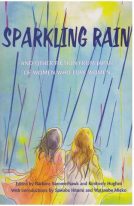 relates to the evolving ideals of masculinity as defined by Japanese society, homosexuality in modern Japanese literature, intercultural relationships, and the subtleties of language.. In 2010, Homosexuality and Manliness in Postwar Japan by Jonathan D. Mackintosh appeared from Routledge, accompanied by Hideko Abe’s Queer Japanese: Gender and sexual identities through linguistic practices. 2011 saw the publication of Jeffery Angles’ Writing The Love Of Boys : origins of Bish?nen culture in modernist Japanese literature from the University of Minnesota Press, and in 2012 Katsuhiko Suganuma explored Contact Moments: The Politics Of Intercultural Desire in Japanese Male-Queer Cultures , issued by the Hong Kong University Press., the publication in book form of his doctoral dissertation from the University of Melbourne. LGBT Japan continues to be a topic explored in theses and dissertations such as A World Like Ours: Gay Men In Japanese Novels and Films, 1989-2007 by Nicholas James Hall , accepted at the University of British Columbia in 2013.
relates to the evolving ideals of masculinity as defined by Japanese society, homosexuality in modern Japanese literature, intercultural relationships, and the subtleties of language.. In 2010, Homosexuality and Manliness in Postwar Japan by Jonathan D. Mackintosh appeared from Routledge, accompanied by Hideko Abe’s Queer Japanese: Gender and sexual identities through linguistic practices. 2011 saw the publication of Jeffery Angles’ Writing The Love Of Boys : origins of Bish?nen culture in modernist Japanese literature from the University of Minnesota Press, and in 2012 Katsuhiko Suganuma explored Contact Moments: The Politics Of Intercultural Desire in Japanese Male-Queer Cultures , issued by the Hong Kong University Press., the publication in book form of his doctoral dissertation from the University of Melbourne. LGBT Japan continues to be a topic explored in theses and dissertations such as A World Like Ours: Gay Men In Japanese Novels and Films, 1989-2007 by Nicholas James Hall , accepted at the University of British Columbia in 2013.
One feature of Japanese LGBT culture which has exerted an influence on the rest of the planet via the Internet is the phenomenon of manga, the gay erotic comics featuring emphatically masculine figures. Readers interested in books on manga will find several works available from the current decade. The Passion of Gengoroh Tagame: Master Of Gay Erotic Manga is a compilation of the work of one of the most recognizable artists creating manga in the twenty-first century assembled by the artist and with an introduction by Edmund White. It appeared in 2013 from a Brooklyn, New York publisher and is a translation from the Japanese. A more general treatment of the genre followed in 2014 from Fantagraphics Books in Seattle, Massive : Gay Erotic Manga And The Men Who Make It is likewise a translation from a Japanese original and the first anthology created in English to introduce nine of the established artists creating manga for the Japanese gay audience (and via the Internet for the planet as a whole). Materials on each of the artists include interviews, photography, and essays on their work as well as illustrations and examples of their manga. In addition to Gengoroh Tagame, the artists profiled are Jiraiya, Seizoh Ebisubashi ,Kazuhide Ichikawa, Takeshi Matsu, Fumi Miyabi, Inu Yoshi, Gai Mizuki and Kumada Poohsuke.
The range of media through which LGBT Japan speaks to the world, from classical tales to online collection of manga, reveals a world that is and has been distinctively defined and influential on the global stage, and continues to contribute a unique voice to the global dialogues conducted by and about LGBT people.
References
Abe, Hideko. Queer Japanese : Gender And Sexual Identities Through Linguistic Practices . New York : Palgrave Macmillan, 2010.
Angles, Jeffrey. Writing The Love Of Boys: Origins of Bish?nen Culture In Modernist Japanese Literature Minneapolis : University of Minnesota Press, c2011.
Chalmers, Sharon. Emerging Lesbian Voices From Japan. London; New York : RoutledgeCurzon, 2002
Cleaver, Richard. Men I Have Loved : A Japanese Gay Memoir : An Annotated Translation Of Umeki Shigenobu’s Ore ga aishita otokotachi . M.A. thesis, Sheffield University, School of East Asian Studies; 1998.
Crompton, Louis. Homosexuality & Civilization. Cambridge, Massachusetts : Belknap Press of Harvard University Press, 2003 .
Crompton, Louis. “Pre-Meiji Japan: 800-1868 “ In Homosexuality & Civilization by Louis Crompton. Cambridge, Massachusetts : Belknap Press of Harvard University Press, 2003: 411-443.
Genders, Transgenders and Sexualities In Japan edited by Mark McLelland and Romit Dasgupta. London: Routledge, 2005.
The Greenwood Encyclopedia Of LGBT Issues Worldwide edited by Chuck Stewart. Santa Barbara, California: ABC-CLIO, 2009.
Hall, Nicholas James. A World Like Ours : Gay Men In Japanese Novels And Films, 1989-2007. University of British Columbia. ETD, 2013.
Hawkins, Joseph Raymond. Invisible People: An Ethnography Of Same-sexuality In Contemporary Japan. Ph. D. thesis, University of Southern California, 1999.
Hibbett, Howard S. “ Saikaku “ in Kodansha Encyclopedia of Japan. Tokyo: Kodansha, 1983 : 369-371.
Ishii, Anne. Massive : Gay Erotic Manga And The Men Who Make it . Edited by Chip Kidd and Graham Kolbeins. Seattle : Fantagraphics Books, 2014.
Ito, Satoru and Ryuta Yanase. Coming Out in Japan : The Story of Satoru and Ryuta. Melbourne : Trans Pacific Press ; Distributed in North America by International Specialized Book Services, 2001.
Leupp, Gary P. Male Colors: The Construction Of Homosexuality In Tokugawa Japan. Berkeley , California : University of California Press, 1995.
Mackintosh, Jonathan. D. Homosexuality And Manliness In Postwar Japan . London : Routledge, 2010.
McLelland, Mark. Queer Japan From The Pacific War To The Internet Age. Lanham, Maryland : Rowman & Littlefield, 2005.
Mishima, Yukio. Confessions Of A Mask . New York : New Directions, 1958.
Mishima, Yukio. Forbidden Colors . New York : Knopf, 1968.
Mishima, Yukio. Forbidden Colors . New York : Vintage Books, 1999.
Partings At Dawn: An Anthology of Japanese Gay Literature. Edited by Stephen D. Miller and Paul Gordon Schalow. San Francisco : Gay Sunshine Press, 1996.
Pflugfelder, Gregory M. Cartographies of Desire: Male-Male Sexuality in Japanese Discourse, 1600-1950. Berkeley : University of California Press, c1999.
Plummer, K, and Mark McClelland. “Virtual Ethnography: Using the internet to Study Gay Culture In Japan.” Sexualities. November 2002 5: 387-406,
Queer Japan: Personal Stories of Japanese Lesbians, Gays, Transsexuals, and Bisexuals. Edited by Barbara Summerhawk and Cheiron McMahill. Norwich, Vermont : New Victoria Publishers, 1998
Queer Voices From Japan: First Person Narratives From Japan’s Sexual Minorities. Edited by Mark J McLelland, Katsuhiko Suganuma; and James Welker. Lanham, Maryland : Lexington Books, 2007.
Schalow, Paul Gordon. The Great Mirror of Male Love (Nanshoku okagami) . Ph.D dissertation, Harvard University, 1985.
Sparkling Rain and Other Fiction From Japan of Women Who Love Women. Edited by Barbara Summerhawk and Kimberly Hughes. Chicago, Illinois : New Victoria Publishers, 2008.
Suganuma, Katsuhiko. Contact Moments: The Politics Of Intercultural Desire In Japanese Male-Queer Cultures. Hong Kong : Hong Kong University Press, c2012.
Suganuma, Katsuhiko, Hitoshi Ishida and Ikuko Sugiura. “ Japan “ in The Greenwood Encyclopedia Of LGBT Issues Worldwide . Edited by Chuck Stewart. Santa Barbara, California : ABC-CLIO, 2009 : 419-435.
Tagame, Gengoroh. The Passion of Gengoroh Tagame : Master of Gay Erotic Manga. Introduction by Edmund White. Brooklyn, New York : PictureBox, 2013.
Takenori, Noguchi and Paul Schalow. “ Homosexuality “ in Kodansha Encyclopedia of Japan. Tokyo; Kodansha, 1983 : 217-218.
Treat, John Whittier. Great Mirrors Shattered: Homosexuality, Orientalism, And Japan. New York : Oxford University Press, 1999.
Watanabe, Tsuneo. La voie des éphèbes :histoire et histoires des homosexualités au Japon. Paris : Editions Trismégiste, 1987.
Watanabe, Tsuneo. Love of the Samurai : A Thousand Years of Japanese Homosexuality . London: Gay Men’s Press, 1989.
Watanabe, Tsuneo and Junichi Iwata. Screening The Male : A Thousand Years of Japanese Homosexuality. London : Gay Men’s Press, 1989.
Copyright R. Ridinger 2016
Thanks for the article. Can I add from a fiction/erotica point of view the series by Sedonia Guillone. Although out of print, Gay Tales of the Samurai by E. Powys Mathers is also a worthy addition to the reading list.
Thanks for the additional books- that is an entire genre that needs a column of its own.